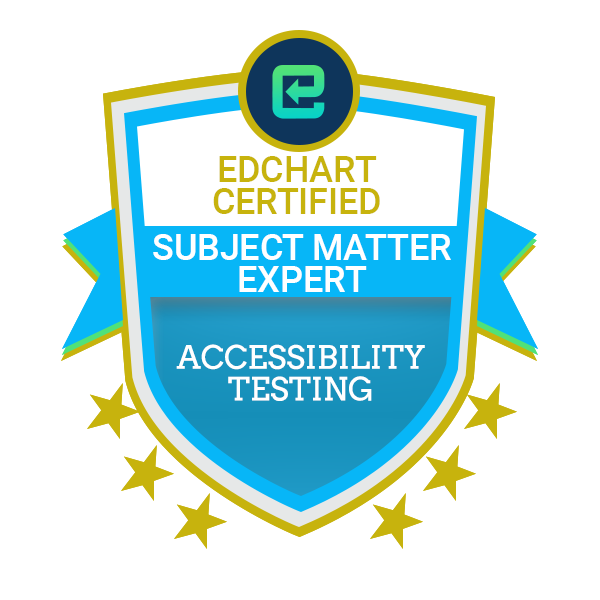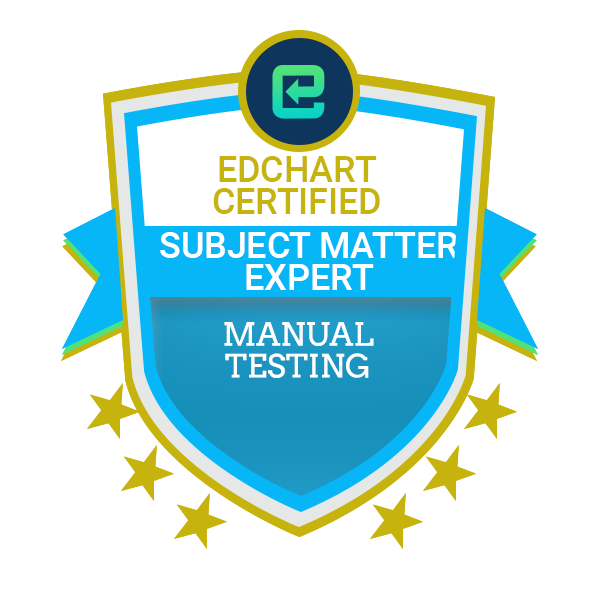
Edchart Certified
Accessibility Testing SME
In today's world, digital accessibility is no longer optional—it’s essential. As businesses expand their digital presence, ensuring that their websites, apps, and platforms are usable by people of all abilities has become a legal and ethical necessity. Accessibility Testing Certification equips professionals with the skills to identify and address accessibility barriers, making digital products more inclusive for everyone.
Accessibility Testing Certification | accessibility testing | mobile accessibility testing | mobile app accessibility testing | accessibility testing online | automated accessibility testing | web accessibility testing | test website accessibility | access certification test | accessibility tester certification | accessibility testing software | colour contrast checker | accessibility guidelines wcag | check contrast | website accessibility checker | ada compliance checker | web accessibility checker | siteimprove accessibility checker | accessibility color checker | wcag testing | accessibility check | online accessibility checker | axe accessibility | accessibility colour checker | accessibility checker for website | screen reader accessibility | web page accessibility checker | wcag aa checker | check color accessibility | accessibility testing service | accessibility testing in software testing | test web page accessibility | accessibility automation | accessibility axe | vpat test | accessibility checker colour |
| India: |
|
|---|---|
|
Other Countries: |
|
Unlocking Opportunities: The Importance of Accessibility Testing Certification
In today's digital age, ensuring that applications and websites are accessible to everyone is more critical than ever. The Accessibility Testing Certification is designed to equip professionals with the necessary skills to evaluate and enhance the accessibility of digital products. This certification not only opens doors for career advancement but also plays a vital role in promoting inclusivity.
Description of Accessibility Testing Certification
The Accessibility Testing Certification provides a comprehensive overview of the principles and practices essential for ensuring that digital products are accessible to all users, including those with disabilities. This certification covers various accessibility standards and guidelines, such as the Web Content Accessibility Guidelines (WCAG) and Section 508 compliance. Candidates learn how to identify accessibility issues through manual testing and automated tools, creating a structured approach to accessibility testing. The certification program includes theoretical knowledge and practical applications, allowing candidates to work on real-world projects. This dual approach ensures that professionals are not only knowledgeable but also equipped with hands-on experience. As businesses increasingly recognize the importance of accessibility, certified professionals will find themselves in high demand. By earning this certification, individuals demonstrate their commitment to creating inclusive digital environments, ultimately enhancing user experience for a broader audience.
Skills Required for Accessibility Testing Certification
To excel in Accessibility Testing Certification, candidates should possess a diverse set of skills. First and foremost, a solid understanding of accessibility standards, such as WCAG, is crucial. Additionally, familiarity with various assistive technologies, like screen readers and voice recognition software, will greatly enhance a tester's effectiveness. Candidates should also develop strong analytical skills to identify and evaluate potential accessibility issues within digital content. Proficiency in both manual and automated testing tools is essential, as these tools streamline the testing process and improve accuracy. Furthermore, effective communication skills are vital for reporting findings and collaborating with development teams. Testers must be able to articulate issues clearly and offer actionable recommendations for improvement. Finally, a commitment to continuous learning is important in this ever-evolving field, as accessibility standards and technologies continue to change. By honing these skills, candidates will be well-prepared to take on the challenges of accessibility testing.
Scopes of Accessibility Testing Certification
The scope of the Accessibility Testing Certification extends across various industries and job roles. Professionals with this certification can work in web development, software testing, UX design, and compliance management. With the increasing emphasis on inclusive design, organizations are actively seeking certified testers to ensure their products meet accessibility standards. This demand creates opportunities in both public and private sectors, including educational institutions, healthcare organizations, and e-commerce platforms. Certified professionals can also play a vital role in government initiatives aimed at making public services accessible to all citizens. Moreover, as companies prioritize diversity and inclusion, certified accessibility testers can help them build a reputation for social responsibility. This certification not only enhances individual career prospects but also contributes to creating a more inclusive digital landscape for users worldwide.
Pros and Cons of Accessibility Testing Certification
Pros:
-
Career Advancement: Obtaining the Accessibility Testing Certification can significantly enhance your career prospects, as organizations increasingly prioritize accessibility.
-
Skill Development: The certification program helps professionals develop essential skills in accessibility standards, tools, and best practices.
-
Social Impact: By becoming certified, you contribute to a more inclusive digital environment, making technology accessible to everyone.
Cons:
-
Time Commitment: Preparing for the certification may require a significant time investment, particularly for professionals balancing multiple responsibilities.
-
Cost: The financial investment in certification courses and materials can be a barrier for some individuals.
-
Evolving Standards: The field of accessibility is continually evolving, requiring certified professionals to stay updated on the latest guidelines and tools.
Features of Accessibility Testing Certification
The Accessibility Testing Certification offers several key features that set it apart from other certification programs. First, the curriculum is designed by industry experts, ensuring that it remains relevant to current trends and standards. Additionally, the program combines theoretical knowledge with practical applications, allowing candidates to gain hands-on experience through real-world projects. Online learning modules provide flexibility for candidates, making it easier to balance their studies with professional commitments. Furthermore, candidates receive access to a range of resources, including testing tools and templates, to support their learning journey. Upon completion, certified professionals receive a digital badge that can be shared on platforms like LinkedIn, enhancing their visibility and credibility in the job market.
Why Should One Take Accessibility Testing Certification?
Pursuing an Accessibility Testing Certification offers numerous advantages. As organizations increasingly focus on inclusivity, having this certification sets candidates apart in the competitive job market. It demonstrates a commitment to creating accessible digital products, which is increasingly recognized and valued by employers. Additionally, certified professionals are better equipped to identify and address accessibility issues, ultimately enhancing user experiences and ensuring compliance with legal standards. The certification also opens doors to various career opportunities across industries, as organizations seek to hire skilled professionals who can navigate the complexities of accessibility. By investing in this certification, individuals not only enhance their own career prospects but also contribute to a more inclusive society.
Who Will Benefit from Taking Accessibility Testing Certification?
The Accessibility Testing Certification is beneficial for a wide range of professionals. Web developers and designers can enhance their skills by learning how to create more accessible digital products. Software testers can gain valuable knowledge to ensure their applications meet accessibility standards. UX designers can improve user experience by incorporating accessibility considerations into their designs. Additionally, project managers and compliance officers will benefit from understanding how to implement and oversee accessibility initiatives within their organizations. Even educators and trainers can use this certification to create more inclusive learning environments. Ultimately, anyone involved in the development, testing, or management of digital products will find that this certification significantly enhances their skill set and professional value.
1. What is Accessibility Testing?
Accessibility testing ensures that software applications are usable by people with disabilities. This involves evaluating the product against various accessibility standards and guidelines, such as the Web Content Accessibility Guidelines (WCAG) of the Rehabilitation Act. It aims to identify barriers that may prevent users with disabilities from interacting effectively with the application.
2. Why is Accessibility Testing Important?
Accessibility testing is essential for several reasons. It helps organizations comply with legal regulations, enhances the user experience for all users, and fosters inclusivity. By ensuring that applications are accessible, businesses can reach a broader audience and avoid potential lawsuits related to discrimination against individuals with disabilities. Professionals seeking Accessibility Testing Certification should understand these implications fully.
3. What are the WCAG guidelines?
The Web Content Accessibility Guidelines (WCAG) are a set of recommendations designed to make web content more accessible to people with disabilities. They cover various aspects of web design, including text alternatives, adaptable layouts, and easy navigation. The guidelines are organized around four principles: Perceivable, Operable, Understandable, and Robust (POUR). Understanding these guidelines is crucial for anyone pursuing Accessibility Testing Certification.
4. What are the common types of disabilities considered in Accessibility Testing?
Common types of disabilities include visual impairments, hearing impairments, motor disabilities, and cognitive disabilities. Each type requires specific testing strategies to ensure that the application is accessible. For example, individuals with visual impairments may rely on screen readers, while those with hearing impairments may require captions for audio content.
5. Can you explain the difference between accessibility and usability?
Accessibility focuses on ensuring that all users, including those with disabilities, can access and interact with the application. Usability, on the other hand, refers to how easily all users can navigate and use the application. While both concepts overlap, accessibility testing specifically targets barriers faced by individuals with disabilities.
6. What tools can be used for Accessibility Testing?
There are various tools available for accessibility testing, including automated testing tools and manual testing methods. Popular automated tools include Axe, WAVE, and Lighthouse. Manual testing often involves using screen readers or keyboard navigation to identify accessibility issues. Candidates pursuing Accessibility Testing Certification should be familiar with these tools.
7. What role does semantic HTML play in accessibility?
Semantic HTML refers to using HTML markup that conveys meaning about the content it contains. Proper use of semantic elements, like headings, lists, and links, enhances accessibility by providing context to assistive technologies. Understanding the importance of semantic HTML is essential for achieving compliance with accessibility standards.
8. How do you test for keyboard accessibility?
Keyboard accessibility testing involves ensuring that all interactive elements of an application can be navigated and activated using only a keyboard. This is crucial for users with motor disabilities who may not be able to use a mouse. Testers should check that all functionalities are accessible through keyboard shortcuts and tab navigation.
9. What is ARIA, and how does it enhance accessibility?
The Accessible Rich Internet Applications (ARIA) specification provides additional semantics to HTML elements, helping assistive technologies understand dynamic content. ARIA roles, states, and properties enhance the accessibility of complex web applications. Knowledge of ARIA is vital for those pursuing Accessibility Testing Certification, as it allows for the creation of more accessible applications.
10. What strategies can be implemented to improve accessibility in software development?
Several strategies can be implemented to enhance accessibility, including conducting regular accessibility audits, integrating accessibility into the software development lifecycle, and providing accessibility training to team members. Additionally, organizations should involve users with disabilities in the testing process to identify real-world accessibility issues.
In conclusion, the Accessibility Testing Certification is an essential qualification for professionals aiming to excel in the growing field of accessibility. By earning this certification, you can unlock new career opportunities and contribute to creating a more inclusive digital world. Visit EdChart to learn more about the certification and how it can benefit you.
| Exam Timing: | 60 (Mins) |
|---|---|
| Pass Per | 60% |
| Level | Expert |
| Roles | Software Testing |
| No. of Questions | 30 |
International Recognized Certificates
Get Your Verifiable and Shareable International Digital Certificates
Industry-oriented Skill Sets
Industry experts suggested knowledge-centric Certificates
Edchart Global User Profile
Edchart Global User Profile for each candidate to share and have.




